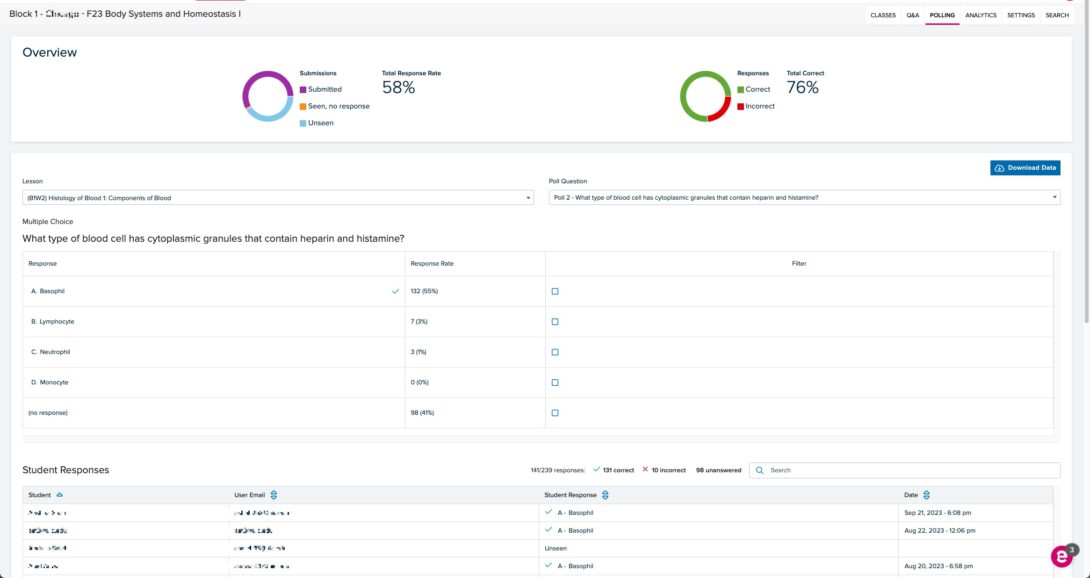Multimedia Interactivity for Improving Information Retention
Innovate to Educate
For most adult learners, engaging in some way with curricular content aids in their retention of information. For many years now, the Illinois Medicine Curriculum has included different modes of interactive teaching and other interactive learning experiences such as team-based learning (TBL) and flipped classroom sessions. For these types of sessions, students are expected to prepare in advance so they can interact with the content, their instructors, and their peers, thus building on pre-existing schemas of information and advancing long-term retention of new information.
Below is a screenshot of an M1 course explaining the required (or supplementary) pre-work students are expected to complete prior to attending a live session.
Example of Interactivity

Some of the pre-work students are expected to complete can include reading textbook chapters and scholarly articles or perhaps watching educational videos, which might include videos from Osmosis, professional organizations, or video content recorded by our faculty. Both of these teaching modalities can be passive learning experiences which can result in less effective retention of information. In the past two years, faculty have made a concerted effort to include more interactivity in video-based pre-work assignments that we house in lecture capture system. This blog post gives you a sampling of some of the work we have put into making our curricular content stronger and more student-centric based on current multimedia frameworks and theories.
Here’s what we did and how we did it.
Integrating Interactivity in Echo360
At UICOM, we use Echo360 primarily as our mode of delivery for video content. Video content we house within this service includes scheduled learning activities (e.g., lecture, TBL, flipped classroom) and any pre-recorded videos that are created by faculty for pre-work assignments or standalone learning modules. A few years ago, Echo360 introduced a way to insert polling in videos at specific timestamps. While there are multiple options for interactivity to add to video (multiple choice, short answer, ordered list, numeric, image), the two types we utilize the most are multiple choice and short answer.
Faculty interested in adding interactivity to their videos work closely with Dr. Max Anderson (Director of Instructional Design and Learning Innovation) and Phil Berfulfo (Videographer / Multimedia Designer) in the Office of Educational Affairs. For example, a faculty member might tell Dr. Anderson to add a multiple choice question (MCQ) to a specific pre-work video at a particular timestamp. Either Dr. Anderson or Phil inserts the MCQ and then shows the faculty member what it will look like to get their approval prior to making it available to students. Project managers and coordinators at each campus ensure the video with interactivity gets added to the course in Echo360 and shared with students. Student feedback has been universally positive. Feedback includes “why don’t all videos have these types of questions?”
Providing Analytics for Continuous Quality Improvement
The Office of Educational Affairs provides faculty and administration with analytics to demonstrate to them how students are more likely to watch their pre-work videos with interactivity than they were before the same video had embedded interactivity in previous years. As faculty are presented with usage analytics, they are more encouraged to insert interactivity in their videos as well.
For fall term 2023, Dr. Anderson worked with Dr. Katherine Simeon, director of assessment and evaluation for the college to include some more general open-ended questions for a few videos. For example, they added “What is one important thing you learned from this section (of the video)” in a video on histology of blood for Block 1 in Phase 1 and they were both impressed by how some students responded. One student wrote “The blood is important for the transport of nutrients and the removal and metabolic waste such as CO2, lactic acid and NH3. The blood is also important for pH maintenance and carrying WBCs, and platelets.” Another student responded with: “Blood is not only important for transporting nutrients, oxygen, and other proteins/cells to the rest of our body, but it has additional functions of removing metabolic wastes and maintaining body pH and temperature.”
Example

This is an example of feedback we can obtain from students who complete the embedded interactivity in faculty-created Echo360 videos. Note we can see also how individual students responded to the embedded questions.
This process has been very successful as we review view analytics from year to year. Video content with embedded multimedia is almost always viewed by more students than the same video without the interactivity (if used previously). We mentioned this already in this post, and just want to make it clear that this has been popular and welcome by students, faculty, and administration.